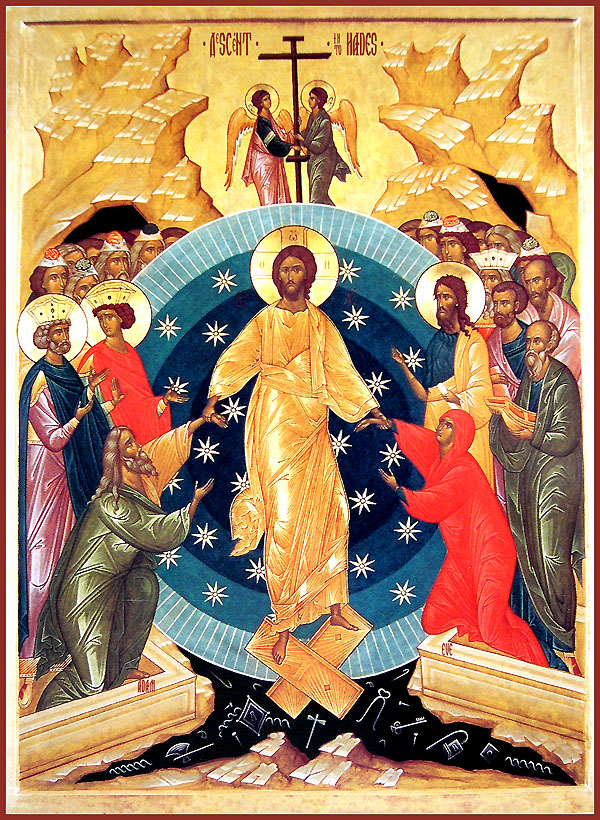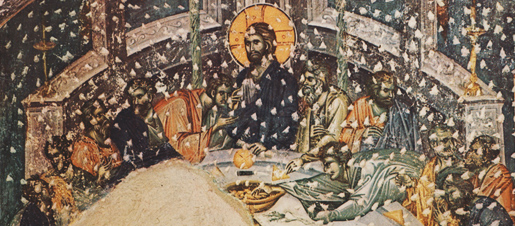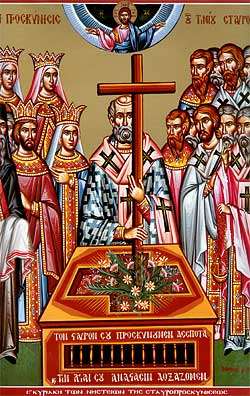Life & Faith
Great and Holy Saturday
 Great and Holy Saturday is the day on which Christ reposed in the tomb. The Church calls this day the Blessed Sabbath.
Great and Holy Saturday is the day on which Christ reposed in the tomb. The Church calls this day the Blessed Sabbath.
“The great Moses mystically foreshadowed this day when he said:
God blessed the seventh day.
This is the blessed Sabbath
This is the day of rest,
on which the only-begotten Son of God rested from all His works....”
(Vesperal Liturgy of Holy Saturday)
By using this title the Church links Holy Saturday with the creative act of God. In the initial account of creation as found in the Book of Genesis, God made man in His own image and likeness. To be truly himself, man was to live in constant communion with the source and dynamic power of that image: God. Man fell from God. Now Christ, the Son of God through whom all things were created, has come to restore man to communion with God. He thereby completes creation. All things are again as they should be. His mission is consummated. On the Blessed Sabbath He rests from all His works.
Great and Holy Friday
 According to the New Testament, Jesus was arrested in the Garden of Gethsemane by the Temple Guards through the guidance of his disciple, Judas Iscariot. Judas received money for betraying Jesus. He told the guards that whomever he kisses is the one they are to arrest. Jesus was brought to the house of Annas, who is the father-in-law of the current high priest, Caiaphas. There he is interrogated with little result, and sent bound to Caiaphas the high priest, where the Sanhedron had assembled (John 18:1-24).
According to the New Testament, Jesus was arrested in the Garden of Gethsemane by the Temple Guards through the guidance of his disciple, Judas Iscariot. Judas received money for betraying Jesus. He told the guards that whomever he kisses is the one they are to arrest. Jesus was brought to the house of Annas, who is the father-in-law of the current high priest, Caiaphas. There he is interrogated with little result, and sent bound to Caiaphas the high priest, where the Sanhedron had assembled (John 18:1-24).
Conflicting testimony against Jesus is brought forth by many witnesses, to which Jesus answers nothing. Finally the high priest adjures Jesus to respond under solemn oath, saying "I adjure you, by the Living God, to tell us, are you the Anointed One, the Son of God?" Jesus testifies in the affirmative, "You have said it, and in time you will see the Son of Man seated at the right hand of the Almighty, coming on the clouds of Heaven." The high priest condemns Jesus for blasphemy, and the Sanhedron concurs with a sentence of death (Matthew 26:57-66). Peter also denies Jesus three times during the interrogations. Jesus already knew that Peter would deny him three times.
Holy and Great Thursday
 On the evening of this day, which was the eve of the feast of unleavened bread (that is, the Passover), our Redeemer supped with His twelve disciples in the city. He blessed the bread and the wine, and gave us the Mystery of the Divine Eucharist. He washed the feet of the disciples as an example of humility. He said openly that one of them was about to betray Him, and He pointed out the betrayer by revealing that it was he "that dippeth his hand with Me in the dish." And after Judas had straightway gone forth, Jesus gave the disciples His final and sublime instructions, which are contained in the first Gospel Reading of the Holy Passion (John 13:31-18:1 known as the Gospel of the Testament). After this the God-man went forth to the Mount of Olives, and there He began to be sorrowful and in anguish. He went off alone, and bending the knees He prayed fervently. From His great anguish, His sweat became as it were great drops of blood falling to the ground. As soon as He had completed that anguished prayer, lo, Judas came with a multitude of soldiers and a great crowd; on greeting the Teacher guile fully with a kiss, he betrayed Him.
On the evening of this day, which was the eve of the feast of unleavened bread (that is, the Passover), our Redeemer supped with His twelve disciples in the city. He blessed the bread and the wine, and gave us the Mystery of the Divine Eucharist. He washed the feet of the disciples as an example of humility. He said openly that one of them was about to betray Him, and He pointed out the betrayer by revealing that it was he "that dippeth his hand with Me in the dish." And after Judas had straightway gone forth, Jesus gave the disciples His final and sublime instructions, which are contained in the first Gospel Reading of the Holy Passion (John 13:31-18:1 known as the Gospel of the Testament). After this the God-man went forth to the Mount of Olives, and there He began to be sorrowful and in anguish. He went off alone, and bending the knees He prayed fervently. From His great anguish, His sweat became as it were great drops of blood falling to the ground. As soon as He had completed that anguished prayer, lo, Judas came with a multitude of soldiers and a great crowd; on greeting the Teacher guile fully with a kiss, he betrayed Him.
The Third Sunday Of Great Lent: Sunday Of The Veneration Of The Holy Cross
 Introduction
Introduction
On the Third Sunday of Great and Holy Lent, the Orthodox Church commemorates the Precious and Life-Giving Cross of our Lord and Savior Jesus Christ. Services include a special veneration of the Cross, which prepares the faithful for the commemoration of the Crucifixion during Holy Week.
Historical Background
The commemoration and ceremonies of the Third Sunday of Lent are closely parallel to the feasts of the Veneration of the Cross (September 14) and the Procession of the Cross (August 1). Not only does the Sunday of the Holy Cross prepare us for the commemoration of the Crucifixion, but it also reminds us that the whole of Lent is a period when we are crucified with Christ.
As we have “crucified the flesh with its passions and desires” (Galatians 5:24), and will have mortified ourselves during these forty days of the Fast, the precious and life-giving Cross is now placed before us to refresh our souls and encourage us who may be filled with a sense of bitterness, resentment, and depression. The Cross reminds us of the Passion of our Lord, and by presenting to us His example, it encourages us to follow Him in struggle and sacrifice, being refreshed, assured, and comforted. In other words, we must experience what the Lord experienced during His Passion - being humiliated in a shameful manner. The Cross teaches us that through pain and suffering we shall see the fulfillment of our hopes: the heavenly inheritance and eternal glory.
Holy Martyr Codratus of Corinth
 In a time of persecution of Christians, many of the faithful fled to the mountains and caves. The mother of this Codratus did so. She was pregnant just at that time, and gave birth to Codratus in a forest, dying almost at once. He was kept safe and fed by the provi-dence of God and his guardian angel. Codratus grew up in solitude with nature. He who gave manna from heaven to the Israelites in the wilderness released a sweet dew from a cloud onto the mouth of the child Codratus. When he was twelve years old, he went down to the town, and there some good people took a fancy to him and educated him. He studied medicine and then began to heal the sick, using both natural medicines and, more importantly, the spiritual power and prayer which had been with him from childhood. When a new persecution arose under Decius, Codratus was taken for trial and thrown into prison. Five of his friends stood beside him and confess-ed the name of Christ. They were: Cyprian, Dionysius, Anectus, Paul and Crescens. They were all dragged through the streets and struck with sticks and stones by the unbelievers, especially by the children, until they arrived at the scaffold. Here the martyrs prayed to God and were beheaded with the sword. A spring of water gushed out onto the earth at the spot, which to this day is called by Codratus's name and commemorates the heroic death for Christ of the holy six. They suffered with honour for the truth in Corinth in the year 250, in the time of the Emperor Decius and his governor Jason.
In a time of persecution of Christians, many of the faithful fled to the mountains and caves. The mother of this Codratus did so. She was pregnant just at that time, and gave birth to Codratus in a forest, dying almost at once. He was kept safe and fed by the provi-dence of God and his guardian angel. Codratus grew up in solitude with nature. He who gave manna from heaven to the Israelites in the wilderness released a sweet dew from a cloud onto the mouth of the child Codratus. When he was twelve years old, he went down to the town, and there some good people took a fancy to him and educated him. He studied medicine and then began to heal the sick, using both natural medicines and, more importantly, the spiritual power and prayer which had been with him from childhood. When a new persecution arose under Decius, Codratus was taken for trial and thrown into prison. Five of his friends stood beside him and confess-ed the name of Christ. They were: Cyprian, Dionysius, Anectus, Paul and Crescens. They were all dragged through the streets and struck with sticks and stones by the unbelievers, especially by the children, until they arrived at the scaffold. Here the martyrs prayed to God and were beheaded with the sword. A spring of water gushed out onto the earth at the spot, which to this day is called by Codratus's name and commemorates the heroic death for Christ of the holy six. They suffered with honour for the truth in Corinth in the year 250, in the time of the Emperor Decius and his governor Jason.
40 Holy Martyrs of Sebaste
 In the year 313 Saint Constantine the Great issued an edict granting Christians religious freedom, and officially recognizing Christianity as equal with paganism under the law. But his co-ruler Licinius was a pagan, and he decided to stamp out Christianity in his part of the Empire. As Licinius prepared his army to fight Constantine, he decided to remove Christians from his army, fearing mutiny.
In the year 313 Saint Constantine the Great issued an edict granting Christians religious freedom, and officially recognizing Christianity as equal with paganism under the law. But his co-ruler Licinius was a pagan, and he decided to stamp out Christianity in his part of the Empire. As Licinius prepared his army to fight Constantine, he decided to remove Christians from his army, fearing mutiny.
One of the military commanders of that time in the Armenian city of Sebaste was Agricola, a zealous champion of idolatry. Under his command was a company of forty Cappadocians, brave soldiers who had distinguished themselves in many battles. When these Christian soldiers refused to offer sacrifice to the pagan gods, Agricola locked them up in prison. The soldiers occupied themselves with prayer and psalmody, and during the night they heard a voice saying, “Persevere until the end, then you shall be saved.”

